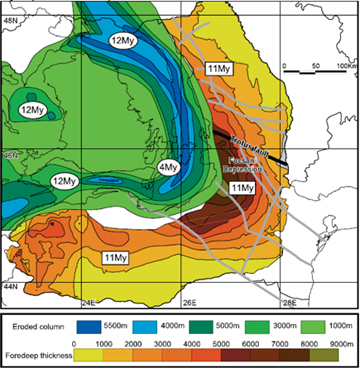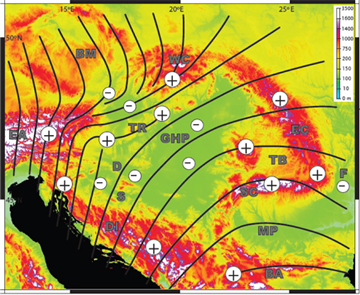| © 2008 by SourceSink consortium - all rights reserved |
Problem statement: The Danube setting is a dynamic source to sink system, characterized by spatial-temporal variations of differential vertical motions, and hence erosion rates.
 |

(Left) Contours of amount of erosion and thickness of foredeep sediments; (Right) Topography of the area and Quaternary uplift and subsidence |
Although much progress has been made recently to understand the source-sink system and the linked inter and intra relationships, detailed studies addressing rates and timing of the various processes with high enough resolution, are still lacking, hampering a full understanding. The nature and rate of differing geomorphic-climatic processes that deliver sediments to valleys vary markedly in tectonically stable and tectonically active settings. This results in significant variability in sediment transfer relationships, with rapid transfer of materials in some landscapes, extensive residence times of storage units in others, and landscapes in which sediment transfer linkages may be spatially and temporally disconnected, but can become connected later due to change in geomorphic and or tectonic settings. Important is also to recognize that these processes determine the occurrence and nature of the detrital minerals in the various sinks, to be studied. Only when detailed enough information on spatial distributions and variations in time is available for the sediment flux, threshold conditions under which erosion products are retained or reworked can be identified and constrained, enabling to studying events controlling production and dispersal of sediments in large drainage systems like the Danube SOURCE-SINK system.
In this IP we will focus our attention to the Dacic Basin, the Transylvania Basin and the Danube Delta and key source regions, primary and secondary Recent studies have proven that application of low thermal geochronology has the ability to obtain the required constraints on timing and quantification of erosion rates for the source regions and for sedimentary rocks on denudation and erosion rates of the hinterland. To study the complete source to sink system from mountain to delta, including the sediment transport ways and dispersal systems, and to quantitatively address spatial and temporal variations in thresholds, is novel.
Aims and objectives: Previous studies applying low thermal geochronology in East and South Carpathians of the study region have mainly focused on the bedrocks of the source areas, revealing spectacular results on exhumation rates in time. Ongoing research more focused on some key sites in the orogen-basin system with emphasis on the basins, show preliminary results indicating that for most of the geological evolution of the orogenic-basins system tectonics is the dominant process recorded in external and internal orogenic units and intramontane basins. Climate, more dominant in the Middle Pleistocene to Holocene times is mainly recorded in the hinterland and foreland basins.
The main objective of this project is, by focusing on getting a detailed low thermal geochronologic data-set of the young sediments at the deltaic sink and key stratigraphic layers, for the first time to systematically inventory and reconstruct dynamic aspects of the complete source-sink chain, by determining constraints on timing and quantification of erosion rates and their spatial and temporal variation, applying the lag-time principle, and to link them to the forcing factors. To validate obtained results and to assess the meaning, in particular in terms of (neo)tectonic, adjustment of isostacy to variation in sedimentary loading and unloading and climatic-geomorphologic processes, it will be necessary to investigate key samples of wells in the foreland and hinterland basins as well. The results will be compared with the data of source areas, known from our own and other studies and be used as input for thermal and numerical integrated lithospheric-surface modelling.
It is aimed, in case the data set is detailed enough, even to investigate which process at what time in the complete source-sink chain was the most active, and therefore being responsible for a particular supply of sediments in the various sinks and or erasing the signal of the source area during transport and local storage or even in the sink sites.
The third objective is to identify possible discharge signals archived in the sediments and revealed by the applied methodologies that may yield crucial clues on what process was the dominant active one and so revealing the ability to interpret the data-set in terms of (neo)tectonics activity and/or climate processes.
So, the major challenge is to link the inventories to the interrelated processes responsible for the redistribution of the mass: tectonics and climate.
Methodologies/experiments: Noble gas and fission track thermochronometric systems cover cooling histories ranging from ~60 to ~ 550 degrees, making them useful to study exhumation of bedrocks and sediments through crustal depths of ~ one to tens of km. Thus, thermochronology can constrain erosion rates and their spatial-temporal variations on timescales of ~ 105 – 107 years. Although we will concentrate on FT and (U-Th)/He analysis, Ar-Ar dating will be included. Recent advances in low temperature geochronometry techniques, in particular fission track analyses and (U-Th)/He being applied on the same mineral, apatite and zircon provide the ability and means to obtain the required constraints on timing and quantification in the source (mountainous hinterland), transport ways and local sinks (foreland deeps), and final sink (the delta), covering orogenic growth and decay cycles and climate-tectonic feedback response times.
Together with a petrographic inventory of the sediments it will be possible to identify the sources, when using the more robust Ar-Ar mica and FT and (U-Th)/He zircon, but even the more temperature sensitive apatite FT and (U-Th)/He systems. Using this approach in foreland and hinterland basins, in particular well samples of sediments of known stratigraphic ages, corresponding to sediments in the deltaic sink region, will provide the constraints to unravel and reconstruct the nature of and the response to the dynamic processes at and during the transport ways. Adjustments of and responses to sedimentary loading and unloading in time will affect the isostacy of the region, being responsible for the creation of either channels or thresholds for the sediments. This issue is very important for the semi-closed Black Sea basin system that is very sensitive to small variation of boundary conditions.
Iterative and inverse statistical techniques are used to evaluate the proportions in which multiple component age distributions have combined in nature to create a mixed age distribution. Such a treatment of the data is needed in order to properly interpret the meaning and significance of detrital heavy mineral population in depositional basins and modern sediments, which are used to infer the exhumational history of mountains belt, serving as source areas. It has to taken into account that the samples used for analysis may inadequately represent certain parts of the landscape.
Crucial for this project will be to proper understand the importance of mineral concentration, erosion rates and grain size of the detritus at the Delta site. So, part of the study will be addressing potential biases in the detrital population. Related questions that need to be solved:
- are particular sources because of their nature dominant in supplying zircon and apatite, the minerals to be dated and does that mean that obtained data is biased;
- are these sediment deposits reworked as part of the source-carrier-sink system and hence do not longer represent just a primary source, but rather a secondary;
- what is the reason for variation and differential erosion rates between regions;
- what is the effect of grain size, morphology and other physical characteristics of heavy minerals in relation to detrital thermochronology. After all these parameters strongly affect the likelihood of the minerals being sampled for analysis and therefore the result.
It is proposed to restrict the sampling to the same few key stratigraphic sediment layers at various locations along the complete source to sink system, in order to be able to make the correlation and to build up the reconstruction of the dynamic nature of the system in time. Of course this automatically implies that the more recent and present day deposits will reflect the more recent dynamic activities, enabling to make the connection to the GPS data campaign and present seismic activity.
Innovation: For the first time it is proposed to systematically inventory and reconstruct dynamic aspects of the complete source-sink chain, using constraints on timing and quantification of erosion rates and applying the lag-time principle. Applying the double dating approach on the same detrital mineral in the sediments reveal time-temperature histories and erosion rates of the source areas that otherwise are impossible to get.
Added value: The data-set will improve the knowledge of the dynamics of the source sink system, both in the recent past as present day situation. The outcome of this study, constraints on timing and quantification, will be used as input parameters for numerical modeling studies of the whole region, and in particular more local parts that are very sensitive to variations and changing boundary conditions. The results will also be used to obtain better validated constraints on sediment budgets relevant for mass balance reconstructions and redistribution.
Deliverables and/or milestones:
- Time-temperature histories of sources areas archived in present day sediments
- Spatial and temporal variation in erosion rates and estimates of sediment fluxes
- Better understanding of threshold conditions
- Reconstruction of the dynamic nature of the source-sink (sub)system(s)
- PhD thesis and articles in peer reviewed scientific journals
References:
- Cloetingh, S. Bada, G., Matenco, L. Lankreijer, A, Horvath, F. Dinu, C. (2006). Thermo-mechanical modelling of the Pannonian-Carpathian system; models of tectonic deformation, lithospheric strength and vertcal motions. In Gee, D.G., Stephenson, R. (edits). European Dynamics, geological Society, London memoirs, vol32, pp 207-221.
- Sanders, C., P. Andriessen, and S. Cloetingh (1999), Life cycle of the East Carpathian Orogen: erosion history of a doubly vergent critical wedge assessed by fission track thermochronology, J. Geophys. Res., 104, 095-029,112.
- Bojar, A.V, Neubauer, F, Fritz, H. (1998). Cretaceous to Cenozoic thermal evolution of the southwestern Carpathians: evidence from fission track thermochronology. Tectonophysics 297, 229-249.
- Willingshofer, E. Andriessen, P, Cloetingh, S., Neubauer, F. 2001. Detrital fission track thermochronology op Upper Cretaceous syn-orgenic sediments in the South Carpathians (Romania): inferences on the tectonic evolution of a collision hinterland. Basin research 13, 379-395.
- Fugenschuh, B., and S. M. Schmid (2005), Age and significance of core complex formation in a very curved orogen: Evidence from fission track studies in the South Carpathians (Romania), Tectonophyiscs, 404, 33-53.
- Merten, S., Andriessen, P.A.M., Juez-Larré, J., Bertotti, G., Dunai, T.J., 2005. Dating the Exhumation of the Romanian Carpathians: First Results from Apatite (U-Th)/He Thermochronology. Geophysical Research Abstracts 7, Vienna, Austria, 08138.
- Necea, D., Fielitz, W., Matenco, L., 2005. Late Pliocene - Quaternary tectonics in the frontal part of the SE Carpathians: insights from tectonic geomorphology. Tectonophysics 410, 137-156.
- Matenco, L., G. Bertotti, K. Leever, S. Cloetingh, S. Schmid, M. Tărăpoancă, and C. Dinu (2007), Large-scale deformation in a locked collisional boundary: Interplay between subsidence and uplift, intraplate stress, and inherited lithospheric structure in the late stage of the SE Carpathians evolution, Tectonics, 26, TC4011, doi: 4010.1029/2006TC001951.
- Leever, K., L. Matenco, G. Bertotti, S. Cloetingh, and K. G. Drijkoningen (2006), Late orogenic vertical movements in the Carpathian Bend Zone - seismic constraints on the transition zone from orogen to foredeep, Basin Research, 18, 521-545.
- Reiners, R.W. and T. A. Ehlers (2005). Low-temperature thermochronology: techniques, Interpretations, and Applications. Rev. in Mineralogy and Geochemistry, vol 58, 622 pp.
- Reiners R.W. and M.T. Brandon (2006) Using Thermochronology to understand orogenic erosion. Annu. Rev. Earth Planet. Sci. 34: 419-466.
- Bernet M. and C. Spiegel (2004). Detrital thermochronology, provenance analysis, exhumation, and landscape evolution of mountain belts. Geological Soc. of America, special paper, 378, 126 pp.
|